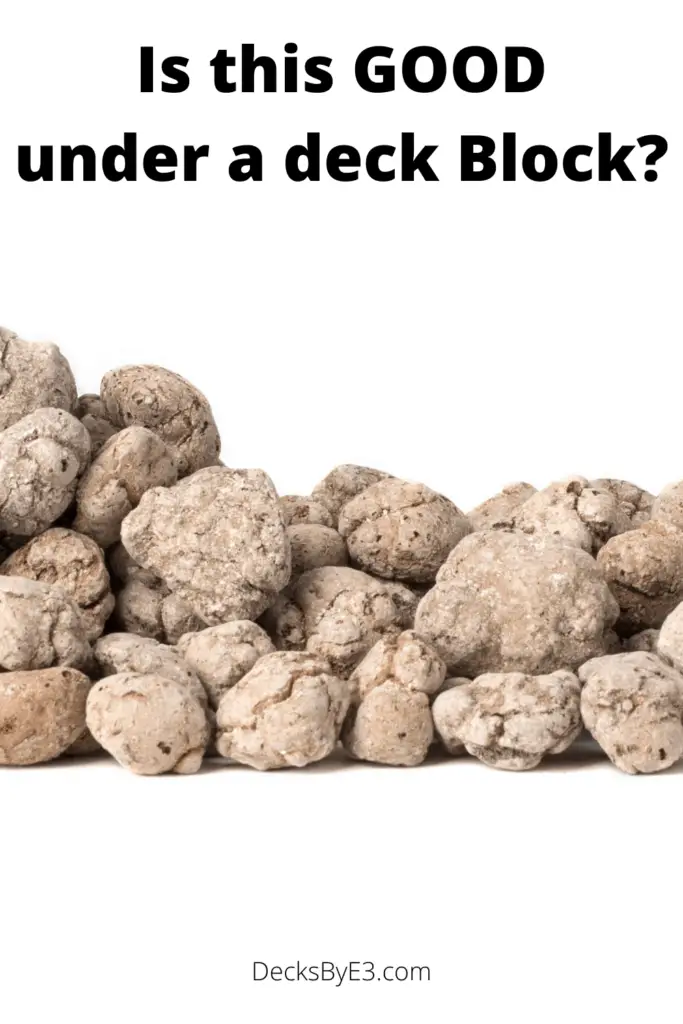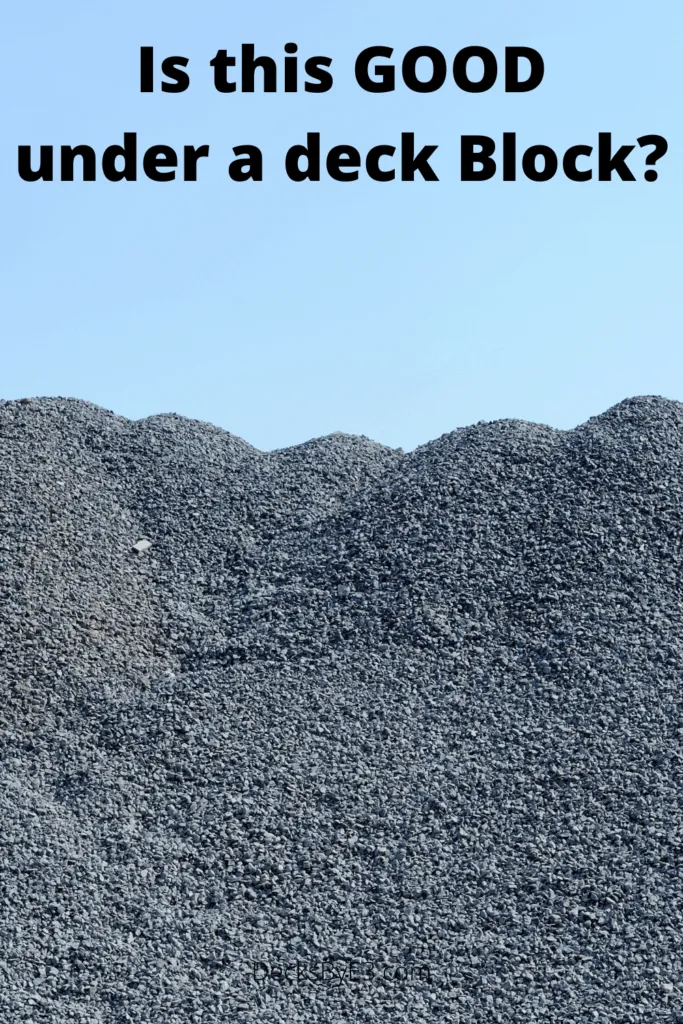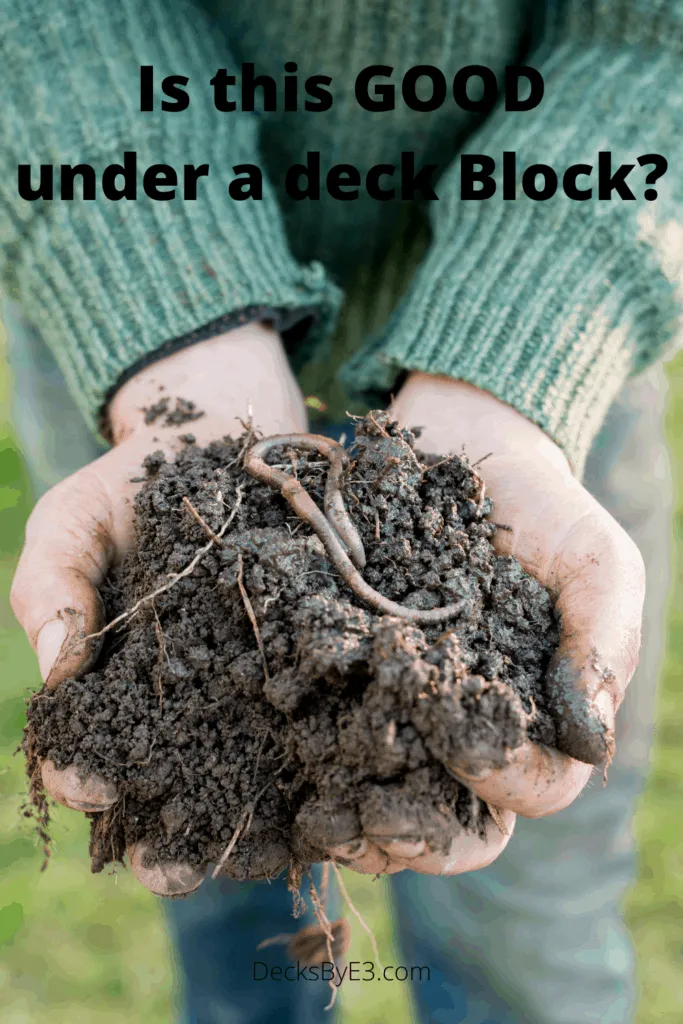Deck blocks are great for building a low backyard deck. You can have stable support for your deck for less than $20 and a half an hour of work. Making deck blocks light work and budget-conscious but giving you a great outdoor living space to enjoy your yard.
But deck blocks are only as good as they are supported. How you install the deck blocks and what you put under them will determine if you have a deck to enjoy for years. Or a pile of junks to haul to the dump.
The deck’s stability and strength and the blocks supporting it are determined by what you put under it.
Deck blocks should be installed on stable, non-organic material with good drainage. You can put gravel, sand, or limestone screening under a deck block. Deck blocks can also be set on poured concrete columns dug to below the frost level. You should not install deck blocks on wood, organic material (Grass) or loam (dark soil).
Before discussing some specific materials for under deck blocks, let’s explain the essential material qualities. Regardless of what you put under a deck block, it must not absorb water but provide good drainage. It must not decompose with time but provide a stable base for years to come.
Material that is easy to work with and level is a bonus. No, easy to level is essential. A large rock may be strong but getting a deck block levelled on it makes a boulder a poor material under a deck block.
Deck Block Base Essentials
You are using deck blocks to provide a stable base for your deck. What you use for the base under the deck block will determine how stable the deck and blocks will be.
Drainage
When water freezes, it expands, and when it melts, it washes away the material around it. Potentially lifting the deck in winter. Then sinking in the spring as the melting snow and ice wash away the ground, creating a pothole under the deck block.
Drainage is the solution. Not as good as footings set below the frost level. But drainage will minimize the impact of water on the deck. Draining the water away from the deck block, removing the potential of damaging the deck.
Non-Organic
Whatever you use to level and support the deck block, it must be stable. Not rotting and decomposing over time or even shift under the deck load. This is why wood is not a good base under a deck block. It may be level during construction, but it can no longer support the deck as it rots and crumble.
Workability
You want something easy to compact and level. Material that can be screeded or even flatten with a hand tamper. Creating a level base for the deck block with minimal work.
With that, let’s look at a few recommended base material to put under a deck block.
Recommended Deck Block Base Material
Gravel, sand and limestone screening all meet the three criteria. They all provide drainage under the deck block, non-organic resisting decay, and are easy to work with.

Gravel under a Deck Block
Gravel provides the best drainage of the three options. A larger granule than the other two, providing more space for water. Gravel sitting under the deck block allows quick drainage, not damming the water preventing it from being absorbed by the ground under the deck block.
Also, gravel is the most stable material with great bearing capacities. A deck block with compacted gravel under it will support more weight than the other two options.
| Material | Bearing Capacity |
| Gravel, or Sandy gravel | 5,000 lbs (2268 kg) |
| Sand, | 3,000 lbs (1360 kg) |
| Clay, sandy clay, silty clay, and clayey silt | 2,000 lbs (907 kg) |
Gravel is a little harder to level than sand or limestone screenings, but a few taps with a tamper will level out the gravel in short order.
Recently I built a floating deck on top of 6×6 post resting on a base of compacted gravel. Click the link for play by play instructions with pictures.

Sand under a Deck Block
Sand is the middle of the road, a compromise of characteristics of material options.
Better drainage than topsoil but not as good as gravel. Compacted sand will slow down drainage but not stop it. Not to the point of pooling, but will hold back some water with sand.
Like when you build a sandcastle on the beach and fill the moat with a bucket of water. It won’t last all day, but you can make a small pool in your castle. The same can happen under the deck.
Continuing with the sandcastle example, you can form sand in your hand way easier than gravel, which is a good thing but at the cost of less strength. Not quite half that of gravel but really close.
But for workability, you can’t get much easier. Sand naturally compacts itself. Simple shovel it into the hole, level with a block of wood and place the deck block.
Because it moves so easily, you will need to lower the block down carefully, evenly and level. Not dropping one corner first, pushing away the sand and making the base unlevel.

Limestone Screening under a Deck Block
The opposite of gravel on the spectrum in regards to size. A fine powder that very easily can be compacted and levelled. Pour into the hole, give it a couple of taps with the tamper and your set.
Similar to sand but a little finer but with the added advantage that limestone naturally prevents weed growth. Which cannot be said for sand.
Poured Concrete Footing under a Deck Block
Not as common as the three other options because generally, you are using deck blocks to avoid the mess and work of concrete. But in some applications, a deck block resting on top of a frost level footing is a good option. The strength of a footing below the heaving frost but clean in appearance. Holding the beam or post up and out of the water.
is a good option. The strength of a footing below the heaving frost but clean in appearance. Holding the beam or post up and out of the water.
Concrete does not provide drainage, but if below the frost level is less critical. If the water cannot freeze, it will not heave.
It is the strongest of all deck block’s material but requiring the most money and work.
I would only suggest this option if the deck does not have skirting , and you really hate the look of unfinished concrete footings under your deck.
, and you really hate the look of unfinished concrete footings under your deck.
Cost of Deck Block Base Material
The first three base materials are economical options. Buying them as sack goods from Lowes or Home Depot or wherever you buy building material will cost less than $10 per block. Limestone Screening is slightly more than sand or gravel, but we are talking pennies a kilogram. Not really something to impact the deck budget.
Of course, no deck has only one deck block. Needing a minimum of four, one for each corner for a smaller deck. Each deck block, increasing the advantage of buying bulk. Ordering one yard of gravel in those handy BigBags gives you enough gravel for under the deck blocks plus some to cover the landscape fabric under the deck. Tidying up the area under the deck with the same material needed for under the deck. One less thing to buy and arrange delivery. A yard will cost around $150 delivered depending on where you live and buy it from. A small price for a weed-free area under the deck and a stable deck.
under the deck. Tidying up the area under the deck with the same material needed for under the deck. One less thing to buy and arrange delivery. A yard will cost around $150 delivered depending on where you live and buy it from. A small price for a weed-free area under the deck and a stable deck.
Time to install is about the same with the three loose options. If you have a lot of deck blocks, gravel will take a little more time to install than sand or limestone. But I am talking minutes, not really a factor in deciding.
Poured Concrete under a deck block is a different story entirely. You should expect to spend a few hours for each deck block and spend around $50 a deck block. The difference between gravel and concrete under the deck blocks.
The difference is between setting the blocks in the morning, framing the deck in the afternoon and order pizza for supper.
Or spending the entire weekend working on the deck footings and eating bologna sandwiches after breaking your back all day.
A better deck but at a price.
Well, that wraps up a few good materials to put under deck blocks. But there are a few you should not.
What Not to Put Under Deck Blocks
Any material that is organic or absorbs water. Organic because it will rot. It may quickly level the deck block today but will collapse in a few years when it rots. The opposite of drainage is absorbing material. If the material under the deck block absorbs water, it will expand and contract with every rainfall. Lifting your deck as it rains and dropping it down when the sun comes out. One day you are playing marbles on your deck. The next, it feels like you are walking the Titanic.

Don’t put wood or grass under Deck Blocks
The first is something I have been tempted while trying to level the deck block. Slipping a little shim under the block or even a chunk of wood. Sure would make quick work of levelling, but you will regret that in the future when it rots.
The same is for grass and leaves. This is more about preparation work before installing the deck block than for levelling. Take a few minutes and dig out the sod where the deck block will go. Providing a stable base for the deck block. It only takes a minute and will pay dividends for years to come as you enjoy your deck.
This article would not be complete without addressing.
When not to use Deck Blocks
Deck blocks are cheap and easy deck footings, but there are a few times you should not use deck blocks.
Don’t Use Deck Blocks When Attaching the Deck to the House
Your house is built on a foundation below the frost level minimizing the impact of frost. You should not attach a floating deck to the house. This will put undue stress on the deck and house as the deck rises and falls with the seasons. Just like when you snap metal by quickly bend it back and forth. The same will happen with your deck and house.
The nails or screws holding the ledger to the house will break off as the deck rises and falls until the fasteners snap. And the deck falls to the ground!
Not to mention the strain on the houses’ foundation. Just like a pry bar pushing against a board. A deck supported by deck blocks will push against the house’s foundation in ways it was never designed for.
If you want to use deck blocks beside your house, build a freestanding deck unconnected to the house.
to the house.
Don’t Use Deck Blocks for a Raised Deck
It varies by city and county, but most jurisdictions have limits on a deck’s height using deck blocks. In most states, it is 30″ (760mm). In Canada, it is 24″ (600mm). Or the way I like to see it. If you can break a foot stepping off the deck, it needs footings below the frost level.
For a low ground level deck. The shifting of deck blocks will have little impact on the deck. But if you add a 6′ (1.8m) post between the deck block and beam, it will make a huge difference. You can tilt a post a few inches on the top by sliding a shim under it. How much more if the ground heaves in winter or drops in spring. If it’s tall, don’t use deck blocks unless you are in Florida with no frost. The rest of use need to grab a shovel and start digging.
Conclusion of Material for Under Deck Blocks
Whatever you choose to put under your deck blocks, make sure it provides drainage, will not rot and is easy to work with. No need to make this more challenging than it needs to be.
But take the time to level the deck blocks properly before building the deck, and you can enjoy your deck for years to come.
